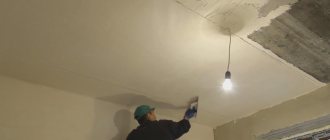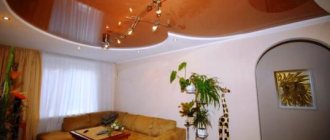Huge space even in a small room
Probably, almost everyone, at least once, has thought about the question: what is the optimal ceiling height. A special science called “living room ergonomics” deals with solving such problems.
It is she who performs calculations of the size of rooms in which a person feels comfortable. Any home should create an atmosphere in which you can relax, recharge your batteries, and feel great.
Standard ceiling heights in a private house: dimensions, features and recommendations
Modern construction applies various standards in the process of designing the interior space of a building.
The standard ceiling height in a private house is 2.7 m. This is quite enough to fully clean and repair the premises. The minimum distance from floor to ceiling should not be less than 2.5 m. This value of the indicator is more often used in country houses where the owners stay temporarily.
For a dacha or cottage, where it is not expected to use various sophisticated design techniques when arranging the interior, this will also be quite sufficient. If you plan to simply paint the ceiling, a height of 2.5 is more than convenient for a country summer house.
Pros and cons of high ceilings
High ceilings give the interior a touch of aristocracy, because palaces are always high, unlike huts. They evoke a feeling of freedom and abundance of air, however, heating this air will require significant additional costs. And at the construction stage, the high ceiling height in the cottage will result in a significant increase in costs in the estimate.
Therefore, it is advisable to limit the height of the rooms to 3-3.2 m, especially since at a higher height their maintenance becomes difficult: replacing light bulbs, maintaining cleanliness, repairs.
SNiP regulate this parameter, but only in multi-apartment residential buildings. The height of ceilings in a private house is not regulated by SNiP, but future private homeowners can take the standards for apartment buildings as a guide.
According to SNiP, the standard value of the minimum height of residential premises depends on the region where the house is built. In cold climatic zones (the Arctic, northern regions of Siberia and the Far East) this value is 2.7 m, in temperate and southern ones - 2.5 m. These standards are calculated based on the conditions for creating a normal microclimate in the rooms.
There are also no standards for the maximum ceiling height in a private house. SNiP does not regulate the maximum ceiling level at all. Practice shows that in modern apartment buildings it, as a rule, does not rise above 3.2 m.
Optimal ceiling height in the house
From the above we can conclude that for the living room on the first floor, which will be large, a high ceiling with a height of 3 m is required. In the bedrooms that are located on the second floor, such a ceiling height is not needed, especially since the area of these rooms is much smaller. Here the ceiling height can be 2.4-2.5 m. By the way, a ceiling height of 2.4 m is considered the minimum comfortable for a person
. In the kitchen, bathroom and toilet there is also no need for high ceilings, so the height of these rooms can fluctuate at 2.5-2.8 m.
When building a private house, it is possible to choose the height of the ceilings in each room. So, many find a height of about 3 m comfortable, while others are accustomed to low ceilings with a height of 2.5 m. And there are also people for whom the ceiling height should only be higher than 3 m. In all cases, the problem of choosing a ceiling height depends on many factors . And the first one is the cost of construction.
. The higher the ceiling in the house, the more expensive it will cost you due to the use of more building materials.
Rational ceiling height
The decision on the length of the walls is made at the housing planning stage, before construction begins. Since there are no standards for this size, it is chosen based on the purpose of the building. The average ceiling height in a private house is 2.7 meters, in a summer house - 2.6 meters, in a bathhouse - 2.5 meters.
Geometric parameters of the room
Experts agree that the ceiling in a private house should be from 2.6 to 3 m. The final result is influenced by the geometric parameters of the room and the layout. For example, the height of the hall and corridor rooms may have minimum dimensions, the kitchen or living room may have maximum dimensions, the height of the attic is determined based on the angle of inclination of the roof.
Regulations
The standard ceiling height in a private house is not dictated by sanitary norms and rules as in multi-apartment high-rises. The regulatory documents indicate only the minimum size of the floors of a private building, which is 250 cm.
Common sizes
Now the ceiling in an individual house is not indicated in any way. Its choice is designed according to the choice of the homeowner, taking into account the accepted dimensions. It makes sense if there are high walls on the floor where the dining room and living room are located. The floor where the sleeping rooms are located can be made lower. A mansard-type house with a pitched roof may have a reduced ceiling height. It is permissible to have a joint at a level of at least one and a half meters. The highest point is not lower than 2.3 meters.
The following generally accepted parameters apply to the height of the premises:
- Bedroom, children's room, kitchen, office - not lower than 2.5 m.
- Entrance hall, corridor, hall - not lower than 2.1 m.
- Attic – 1.5 m and above.
Requirements and Standards
The standard ceiling, according to generally accepted concepts, has a height of 270 centimeters. With this parameter, it is comfortable to live in the building, convenient to clean, and it is not difficult to carry out repairs. This height allows you to design suspended structures in several levels and a suspended ceiling.
Standards for the construction of buildings are usually regulated by the state, the requirements of which are presented in SNiPs. In buildings where people live permanently, these requirements set the minimum size of floors at a level not lower than 260 cm from the floor covering. Although now these rules have lost force and, according to new laws, the height of the ceiling is chosen at the discretion of the house owner. The main thing is not to violate fire safety rules when designing.
Minimum area of construction of a residential building for registration in the BTI
It is not necessary to build a house, it can be any real estate object, i.e. an object that is firmly connected to the ground and its movement without disproportionate damage to its purpose is impossible. Some standards for minimum area, etc. There is no land available for purchase purposes.
It is necessary to take into account that construction can only be done on a plot of land on which construction is permitted and if there are at least some rights to this plot. Otherwise, the object may be recognized as an unauthorized construction and demolished by court decision.
Optimal and standard ceiling heights according to standards and in practice
The height of the ceilings is a pressing issue, since not only the possibility of implementing design projects, but also the comfort of the room as a whole depends on this value. On average, this parameter ranges from 2.4–3.2 meters. The minimum ceiling height is determined by SNiP as 2.5 m. Such ceilings are typical for Khrushchev-era buildings. In new buildings their minimum height is 2.6 meters. And in luxury houses it can be more than 3 m.
If the minimum distance from floor to ceiling is determined by SNiP, then ergonomics is involved in developing optimal parameters. The tasks of this science include calculating the room parameters that will allow a person to feel as comfortable as possible. It's no secret that a room with a low ceiling can feel pressured. A tall room with a small area will also be uncomfortable. Here a person feels as if in a well.
Ceiling design
Ceiling lighting
The design of the ceilings in the room determines not only the stylistic direction of its design, but also the atmosphere of coziness and comfort. In the store you can find a lot of finishing materials for ceiling surfaces.
The specific choice of finishing option will largely be determined by such a parameter as the height of the ceilings.
Ceiling tiles
Ceiling tiles are well suited for rooms with low ceilings. It is distinguished by a variety of designs, excellent performance characteristics and practically does not hide the space of the room. The advantages of this material include ease of installation.
This type of ceiling decoration becomes an excellent alternative to modern options.
However, tiling may have several “surprises” that are not always pleasant. Tiles are not able to hide significant surface irregularities. In addition, with large differences, its sticker will cause many difficulties, and it is almost impossible to guarantee quality in such conditions. There will always be a possibility that the tile will simply peel off.
An uneven ceiling can be pre-leveled, but in this case the tile loses its main advantage as a finishing material for a room with a low ceiling. The leveling layer will “eat” those very carefully stored centimeters of space.
Suspended structures
Hanging structures are a modern way to transform a room and make the design of the room unique. They allow you to do without preliminary preparation of the base surface. Installation of suspended ceiling structures of any type is carried out on profiles, so they reduce the height of the ceiling. Suspended structures can have any configuration and several levels. In the space hidden by them you can hide communications and lighting fixtures.
It is generally accepted that for a room with low ceilings it is better not to use hanging options. However, this is not entirely true. A single-level design with the minimum possible distance from the base surface to the profile allows you to diversify the design of the room, make it stylish and beautiful.
If the room has high ceiling heights, absolutely any design idea can be realized. Suspended structures allow you to create any shapes and configurations, including very complex ones. This design move allows you to solve many everyday problems - increase the sound insulation of a room, zone it, hide communications, “play” with lighting.
Tensile structures
White and black with backlight
Tensile structures are ideal for large spacious rooms. This finishing method is the best in ceiling design today. The canvases are distinguished by a variety of textures and colors. Any pattern can be applied to their surface. The design of multi-level tension structures has no restrictions except the designer’s imagination. The height of the ceilings in the room is the most important parameter for choosing such structures. For rooms with low ceilings, they need to be used with care. Single-level ceilings located approximately 5–10 cm from the base would be appropriate here.
If the height of the ceilings allows, you can diversify the interior as you like. Three- and four-level designs with complex configurations look good in large rooms and living rooms. Arched and hipped structures not only allow you to hide any unsightly communications, but also give the room an unforgettable atmosphere and a very special flavor.
Color solutions
The ideal ceiling design is not only the right choice of finishing material, but also a well-chosen color scheme. Modern finishing materials are distinguished by a wide variety of colors and textures. The same option used in different rooms can give a completely different effect.
The most commonly used design is in light colors - white or pastel shades. Its advantage is the ability to visually expand the space if the ceiling height is low. White ceiling surfaces allow you to use almost any color in the interior. This is an ideal solution for decorating a room in a classic style. The embodiment of a non-standard design idea in the interior may require the design of the shelf surface in different shades.
Eaves lighting
When choosing a color, you should be guided by the following rules:
- The lower the height of the ceiling, the lighter its surface should be. It is advisable to make the floor as dark as possible, and choose the color of the walls in the range between these color schemes. This solution will allow you to visually expand the space.
- With disproportionately high ceilings, their color should be dark, even black. Otherwise, you get the feeling of a deep stone well, which is uncomfortable to be in.
- Warm shades look best in dark rooms, and cool shades look best in light rooms.
What should be the height of the ceilings in a private house?
- A feeling of oppressive space will always accompany a room with a low ceiling. It will be uncomfortable to be in it.
- Limited use of hanging chandeliers. There are houses where the ceiling height is limited to two meters. In such rooms the chandelier will have to be bypassed.
- Limited opportunity to create architectural compositions. If you dream of creating a multi-level design in a room with a low ceiling, you will have to turn to professional designers for help. Creating such a ceiling will be difficult, but possible.
For small living rooms, increasing the ceiling will lead to an uncomfortable feeling. Rooms with low ceilings are optimal for children's rooms, bathrooms and kitchens that do not require a huge area. But living rooms and halls, rooms reserved for a library or warehouse will look great with the highest possible ceiling level in large houses.
Design solutions and ergonomics
From an ergonomic point of view, the parameters of the room should be such that a person feels comfortable in an apartment, gym, or cinema.
There are several basic postulates of room comfort:
- optimal microclimate (comfortable temperature and humidity);
- necessary supply of fresh air;
- sufficient natural or artificial lighting.
The standard ceiling height in an apartment will allow you to create almost any floor structure, with the exception, perhaps, of heavy multi-tiered hanging devices. When making such design solutions, the height from floor to ceiling should be maximum.
In other cases, you can use any materials:
- ceiling tiles;
- tensile structures;
- simple suspended ceilings.
Ceiling tiles are suitable for finishing rooms with any wall height. It practically does not hide or reduce spatial scales. Easy to install and maintain. During repairs, any home craftsman can handle gluing. The only drawback is that it will not be able to level the floor slabs; moreover, when glued to an uneven surface, it can come off and negate all the work in the future.
When leveling the ceiling with plasterboard slabs, all the savings in height will not matter, since the frame of the structure will “eat up” the required centimeters.
Tension fabrics are the most acceptable option for finishing ceilings. They do not require special surface preparation. The width of the profiles on which the canvas is attached is not too large. But it is worth noting that multi-level structures should not be used in rooms with low ceilings. In such rooms, a single-level glossy or matte canvas with spotlights would be optimal.
Tension fabrics with a 3D effect and original lighting are possible, which can be selected taking into account the fact that the ceiling will visually look higher.
Suspended ceilings can bring to life the most daring design solutions. The installation of structures is carried out without preparing the base, especially since it is possible to hide light fittings and other communications under such a ceiling.
With high ceiling heights, you can create a multi-level, stylish and elegant form. In a room with low ceilings, it is better to opt for a single-level option with original built-in lamps or a chandelier that allows you to illuminate the ceiling surface from below.
Optimal height of the second floor in a private house
The standard ceiling height in an apartment (h = 2.5...3.2 meters) often does not allow its owner to realize his interesting design ideas. Having high ceilings in a house is always an advantage, because in such houses there is more light and air, and there is no feeling of enclosed space.
Every person wants his home to be as spacious as possible, therefore, when purchasing a house or apartment, he first of all evaluates its area. But, unfortunately, during their searches, people often lose sight of such a point as the ceiling height for a one-story house. The height of the ceiling can greatly influence the visual perception of the room. If the ceilings are too low, then a person, being in such a room, will constantly experience discomfort and inconvenience.
Non-residential premises
For buildings such as a garage or sauna, there are no strict regulatory frameworks. In this case, the ceiling height is determined by expediency.
For baths and saunas, high ceilings are undesirable, since warming up such a building will be much longer and more difficult.
The height of the garage walls is determined by the vehicles that are in it. For a standard passenger car there is no need to build a garage with high ceilings. But if you have a fairly large vehicle, there is a reason to increase the length of the walls to 3 meters.
Ceiling height in the house
When designing a private house, you need to decide in advance what the ceiling height will be. This decision is serious, since based on this parameter the construction estimate is calculated, which takes into account not only materials, the costs of their delivery, but also the labor intensity of the work. To determine the height of the ceilings, it is worth taking into account several basic rules, including those regulated by state regulations.
In the past, norms and regulations (SNiP) indicated the minimum height of ceilings in a house was 2.5 meters. That is why most buildings have exactly these parameters. Today, standards do not specify exact figures for height, which allows the owners of the future home to show their imagination, relying on the practicality of each option.
Floors in a house made of aerated concrete: requirements, types
The advantages of houses made from aerated concrete blocks are the short construction time. This promotes rapid housing construction, including private housing. The choice of covering the first floor of a house from aerated concrete depends on many factors: the purpose, number of storeys of the house, the possibility of using special equipment, the cost of work, the level of professionalism of the builders and knowledge of the structural features of the materials. The reliability and durability of a building largely depend on the correct solution to this issue.
Content:
Requirements for flooring for a house made of aerated concrete
A house made of aerated concrete is built no higher than three floors, since the cellular structure of the blocks has less compressive strength compared to conventional concrete. The ceiling in such buildings should be selected taking into account:
- self-gravity and floor walls, or weight load calculations;
- strength and optimal rigidity;
- sufficient degree of sound insulation;
- fire safety factor.
The resulting force on the load-bearing walls is redistributed by the ceiling. It is recommended to make a reinforcing belt for any of its types, which enhances the spatial rigidity of the building and provides protection against crushing of fragile aerated concrete.
The upper cut of load-bearing walls must be strictly horizontal; if a defect is detected, elimination can be done by erasing aerated concrete blocks for leveling.
Types of floors
The selected overlap depends on the method of execution and construction material. The following modifications are most widely used:
- slab;
- prefabricated monolithic;
- monolithic;
- based on wooden or metal beams.
Other types of flooring: coffered, brick, hipped, are structurally complex and expensive, and are not used in the construction of low-rise buildings made from aerated blocks.
Slab floor
Installation of floor slabs.
The first floor slab is assembled at the construction site using reinforced concrete slabs or aerated concrete. The choice between them is determined by the fundamental difference in weight. Such construction is the fastest in terms of time and is not related to the seismic activity of the region. The number of slabs depends on the size of the object and the standard dimensions specified at the factory. The main thing is that the span between the walls is 30 cm less than the overlap for a support installation of 15 cm on each side and meets the standards for the maximum distance:
- 6 meters - smooth slabs;
- 9 meters - with ribbed top.
The thickness is selected taking into account the potential load, since the ceiling is a kind of rigidity disk. For a two-story aerated concrete house, a height of 12 to 20 cm is sufficient for smooth surfaces and 25 to 30 cm for ribbed surfaces.
The slabs are laid strictly along the load-bearing walls of the first floor of the same level. The construction of internal partitions takes place later. Before installing the ceiling, a distribution brick pad one brick thick is built on the top row of aerated concrete blocks. After securing the strength, the slabs are placed on the layer of cement mortar using a crane.
Advantages of flooring made of aerated concrete or reinforced concrete slabs:
- fast installation in a short time;
- durability and reliability;
- high load-bearing capacity, from 600 to 800 kg/sq.m;
- excellent heat and sound insulation due to internal voids;
- factory production is distinguished by high-quality processing of materials;
- affordable price.
The disadvantages include:
- the need for special lifting equipment;
- the presence of access roads to the house made of aerated blocks for placing large slabs;
- limiting the choice of slabs by size;
- restrictions in application when load-bearing walls are curved;
- installation experience.
To adhere the slabs, a sand-cement mortar is used or mineral wool is laid, which strengthens the thermal insulation of a house made of aerated concrete.
Prefabricated monolithic floor
The technology does not require special equipment due to the design, which allows for not the heaviest elements for covering the first floor.
The installation process consists of initially placing the beams at a distance of 60-80 cm. Between them, expanded clay or polystyrene concrete blocks are placed on the lower flanges of the beams. A formwork is formed, on top of which a reinforcing mesh is placed. The structure is poured with concrete and takes time to dry completely.
Insulation is carried out using expanded clay, expanded polystyrene, high-density basalt wool or other thermal insulation materials.
The advantages of the design are manifested:
- in carrying out installation without special equipment;
- excellent sound and vapor insulation;
- strength of prefabricated monolithic composition.
But building codes, unfortunately, do not include information and recommendations for this type of flooring. Therefore, its use is allowed in houses made of aerated blocks of no more than 2 floors.
Monolithic ceiling
Preparation for pouring a smooth monolithic floor slab.
This modification is being prepared at the site for building a house. The process is quite complex and labor-intensive, but indispensable for non-standard building shapes. The resulting flat surface and the absence of work on sealing seams attracts the choice of this type of flooring.
At the beginning of the process, it is necessary to install formwork to form a monolithic slab. Based on your financial capabilities and availability of time, you can buy ready-made inventory formwork or make it yourself from sheet materials or boards at the installation site.
Concrete for pouring the floor is prepared according to the classical scheme: three parts sand and one part cement. Add crushed stone or gravel as desired. The first layer of concrete should not exceed one third of the floor; a reinforcement cage is placed on it. Then, using the pie principle, the second filling and laying of the reinforcing mesh is done. After the third pouring of concrete, the total thickness of the floor is 15-20 cm.
Increasing the layer thickness significantly affects the overall weight of the structure. For a house made of aerated concrete blocks, these are significant parameters. When the concrete reaches approximately 80% strength, this occurs within 3-4 days, the formwork can be dismantled.
To reduce the thickness of the floor and the overall structural weight, a ribbed monolithic slab is made, which includes beams and thin concrete layers. In this case, the pressure is redistributed not to the aerated concrete walls, but to the beams.
Formation of a ribbed monolithic slab.
It takes much more time to install formwork with lower sheets of profile metal, which will become the reinforcing base. This option is indispensable in rooms with large spans between load-bearing walls of up to 9 m.
Monolithic slabs do not allow self-production of concrete in small-sized mixers. The solution must be ordered in the parameters and volume for one-time filling of the surface from an organization that guarantees product quality.
Advantages of monolithic floors:
- high load-bearing capacity;
- options for non-standard configurations with geometric complexities;
- application in case of significant spans between walls over 6 m.
Flaws:
- large time costs to set the strength characteristics of concrete;
- mandatory calculation of loads on the structure;
- high cost of overlapping;
- application of equipment: mixers and concrete pumps;
- extensive preparatory work;
- strict adherence to the solution preparation technology;
- limitation of work depending on temperature conditions.
Beam floors
Floors in a house made of aerated blocks can be made using metal or wooden beams.
Installation of wooden floor beams on aerated concrete walls.
The first option has a low price and is popular for installing interfloor structures. The second, similar in construction technology, is very expensive due to the price of rolled metal products and the need for equipment to install heavy beams.
Heat-insulating material is placed between the wooden beams. A sheathing is installed on the beams on both sides, which, on the one hand, serves as the basis for the subfloor, and on the other, as the ceiling surface.
It should be noted that wooden beams must be treated with fire and bioprotective impregnations, and metal floor beams are subject to mandatory anti-corrosion treatment. To prevent moisture from penetrating from the concrete to the beams, a layer of waterproofing is needed.
The beam floor of a house made of aerated blocks has significantly lower load-bearing capacity, so its use is recommended in buildings with a small area and a distance between walls of up to 6 m. This is especially significant for areas with seismic activity over 7 points.
Positive properties of beam technology:
- availability of installation work with metal beams and wooden floors;
- low cost.
Flaws:
- use only in two-story houses;
- shorter service life compared to concrete floors;
- the presence of restrictions due to the flammability of materials.
Any ceiling can be installed in an aerated concrete house, provided that the load on the load-bearing walls is accurately calculated. The optimal load for small buildings of 2-3 floors is when installing aerated concrete slabs. The weight, size of the slabs, average price and technological features of constructing floors with aerated concrete slabs make this choice available in mass housing construction.
Similar articles
abisgroup.ru
Ceiling height in a private house
The optimal ceiling height is different for each person. It all depends on your height. Tall people are comfortable only in rooms with a ceiling height of about 3 m. If the ceiling is low, it seems that it hangs over your head. Determine the optimal ceiling height in the room
It’s very simple: let the tallest family member stand and stretch his arm up. To this height you need to add another 30 cm. The resulting height will be the optimal ceiling height in the room.
- Due to the color scheme. White, light blue, beige, cream, soft yellow and other light shades will help visually expand the room and add volume to it. A dark-colored ceiling, on the contrary, will visually reduce the size of a room in a private home.
- A smart and very original solution is to paint the surface in different colors. For example, place one light square in the center, from which darker shapes will diverge around the perimeter (with each step they should become darker by one tone, creating the effect of a smooth color transition). This “ladder” technique is quite often used in modern interior design.
- You can make a room visually taller with the help of optimal placement of light accents. If you place a large and massive chandelier in the center, it will create a very bulky impression, visually hiding some of the volume of the room. Therefore, if the size of the room is modest enough, in order to visually enlarge it, it is better to use compact and small lamps, and even better - built-in spotlights.
- You can increase the volume of a room with the help of competently and thoughtfully designed walls. For example, wallpaper with vertical stripes or elongated patterns and ornaments will visually make the walls taller. This effect is based on the simplest knowledge of proportions and the laws of geometry, so it is quite easy to reproduce. However, despite all the lightness, it gives a truly amazing result, making the walls taller and the space of the house larger and more spacious.
Peculiarities
The main indicator when buying an apartment is the height of its ceilings, since it is this that opens up enormous possibilities for decorating rooms and affects the perception of space. Therefore, when choosing new housing, you should take into account the optimal size of this indicator. They must not only correspond to the height of the people living in the apartment, but also to the area of the room.
The height is considered normal if at least 30 cm remains from a person’s outstretched arm to the ceiling. For large rooms that combine several functional areas, a height of at least 3.5 m will be comfortable, and for dining rooms and kitchens 2.8 m is sufficient.
Recently, many apartments have installed multi-level suspended ceilings and underfloor heating systems. This type of installation work makes the rooms warm and beautiful, but in this case the height of the room is reduced by 20 cm . Therefore, this finishing option is not suitable for low rooms ; for them you need to create individual projects and select an interior that will not depend on the height of the ceilings.
It is also worth noting that this indicator is determined by the homeowners’ own preferences, since some of them feel comfortable in a room with a height of 3 m, while others, on the contrary, are satisfied with the minimum size of 2.5 m.
Standard ceiling height in a private house: what should it be according to current standards
But now in the private sector they prefer to have high ceilings in residential premises, up to 3 meters. More space, comfort, air. In such a room you can implement any design solutions, including a multi-level ceiling.
The optimal ceiling height in a private house is considered to be 2.7 meters. But according to building codes and fire safety, the permissible minimum ceiling height in a private house (in a residential area) must be at least 2.6 meters. Although a minimum height of 2.5 meters is allowed, there will be no penalties for this, the main thing is that the residents feel comfortable in such a room. Some people feel uncomfortable in a room with a low ceiling.
Features of the boiler room space of a private house
The regulatory framework for a boiler room in a private house is regulated by the following documents:
- until 2003, the rules according to SNiP 04.08-87* were in force;
- from mid-2003 - rules according to SNiP 42-01-2002.
The documents contain rules for installing a boiler room in a private house.
You need to study the rules, but a special organization must design a boiler room for a private home. The owner has the opportunity to choose the installation of one or another boiler, and can estimate the amount of work to adjust the selected room to the established rules.
If any controversial issues arise, you must contact the gas supply organization. There are many nuances when designing a boiler room in a private house. Problems that arise can only be resolved in relation to the construction plan. The choice of installation location for a gas boiler in a boiler room is determined based on its power.
Standard ceiling height
There are no specific standards for the construction of a bathhouse. The main thing is to make the room of such a size that everyone in it feels comfortable. Since steam accumulates above the ceiling, some people like to sit on a shelf in the heat, while others at this time are at a lower level and also feel comfortable. It is believed that a ceiling height of 3 meters in the steam room of a bathhouse will be optimal in order to quickly warm up and retain heat in the bathhouse for a long time.
Apartments designed and built during Stalin's times are called "Stalinkas". Their distinctive feature is the height of the ceilings, or rather the high height, at least 3 meters, often even more. “Stalinka” apartments are quite spacious and large apartments filled with light. In addition to high ceilings, they have wide corridors and spacious kitchens, large doors and windows.
What should be the height of the ceiling in the house?
By adjusting the size of the walls and the technical parameters of the ceiling, you can amazingly correct some of the shortcomings of the room and make it more harmonious and perfect.
According to fire safety and SNiP, the minimum permitted ceiling height in buildings is 2.6 meters. However, as practice shows, in most private houses it would be wiser to create ceilings of a greater height - about three meters. This is the optimal figure that will allow you to create a spacious, voluminous and harmonious room.
Minimum ceiling height in a private house for registration
At the stage of construction work, every owner wants to make the optimal height of the rooms in his house. When choosing this option, you should take into account that you will have to take care of the house and spend resources on its maintenance. To choose the overlap format, it is important to adhere to:
High-rise Brezhnev buildings (from 9 to 16 floors) appeared in the USSR in the 70s. At first, the premises in them were called apartments with an improved layout. If you compare them with the rooms in Khrushchev, then it really looked like the truth. The distance from the floor to the ceiling surface in Brezhnev's houses is 2.5–2.7 m. The total area of the apartment is 20-80 sq. m. m.
Minimum ceiling height in a private house for registration
«4.3 The composition of the premises of the house, their sizes and functional relationships, as well as the composition of engineering equipment are determined by the developer. The house must provide conditions for rest, sleep, hygiene procedures, cooking and eating, as well as for other activities usually carried out in the home.
4.4 The house must include at least the following premises: living room(s), kitchen (kitchen niche) or kitchen-dining room, bathroom or shower room, toilet, pantry or built-in wardrobes; in the absence of centralized heat supply - a room for a heating unit. The house must have heating, ventilation, water supply, sewerage, electricity and radio broadcasting. The area of the premises of the house is determined taking into account the arrangement of the necessary set of furniture and equipment and must be no less than: common living room - 12 m2 bedrooms - 8 m2 (if placed in the attic - 7 m2); kitchens - 6 m2. The width of the premises must be no less than: kitchen and kitchen area in the kitchen-dining room - 1.7 m, hallway - 1.4 m, interior corridors - 0.85 m, bathroom - 1.5 m, restroom - 0.8 m. The depth of the restroom must be at least 1.2 m when the door opens outward and at least 1.5 m when the door opens inward.











